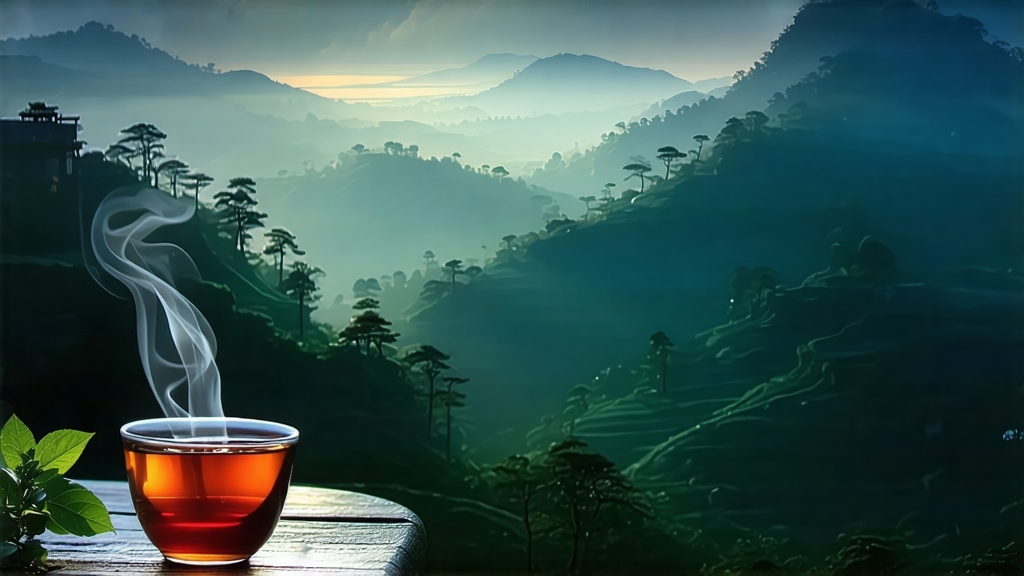
Long before English merchants coined the word “black tea,” Chinese mountain dwellers had already perfected a leaf that would travel the globe and rewrite the story of world trade. That leaf is Lapsang Souchong, today celebrated as the progenitor of every black tea on Earth. Its birthplace is the Wuyi massif in northern Fujian, a UNESCO dual heritage site where basalt cliffs, mineral rivers, and subtropical mists conspire to create one of the most distinctive flavor profiles in the tea lexicon. To understand Lapsang Souchong is to witness the moment when Chinese ingenuity met European craving, when pine smoke met red liquor, and when a tiny village called Tongmu became the unlikely cradle of an international obsession.
Historical records first mention “Xiaozhong” during the late Ming dynasty, around 1604. Local lore claims soldiers passing through Wuyi commandeered fresh leaf intended for green tea; to prevent spoilage, farmers hastily dried the leaves over pine fires, inadvertently creating a smoky, coppery brew that delighted passing Dutch traders. By the early Qing, the Dutch East India Company was shipping chests of “Bohea Lapsang” to Amsterdam and then on to London, where it fetched prices higher than silver. Catherine of Braganza’s dowry to Charles II reputedly included a small casket of Lapsang Souchong, igniting a fashion for smoked tea in the Stuart court. Over centuries the tea rode clipper ships past the Cape of Good Hope, fueled the Boston Tea Party (some chests dumped were indeed Souchong), and perfumed the drawing rooms of Victorian ladies who loved its “cigar-like” bouquet. In modern China the leaf is honored as the first black tea (hong cha, literally “red tea”) ever created, and Tongmu villagers still speak of the “one leaf that changed the mountain.”
Although the name “Lapsang Souchong” is often used generically, true Tongmu Souchong is micro-classified into two families: smoked and unsmoked. Within each family, leaf grades descend from the original “Zhengshan Xiaozhong” (literally “original-mountain small variety”) to everyday “Waishan” copies grown outside the core 600 m elevation band. The highest grade, known as “Jin Jun Mei,” was invented in 2005 when a Tongmu master decided to craft an entirely bud-only version using the same cultivar but reversing the smoking step; its honeyed complexity now commands thousands of dollars per kilogram. Traditionalists, however, revere the classic smoked leaf, made from the indigenous Xingcun Xiaoye cultivar, a small-leaf bush that thrives in Wuyi’s rocky, slightly acidic soils. The terror of counterfeit has led Fujian authorities to grant Tongmu a protected origin status; only leaf processed within the 53 km² core zone may legally bear “Zhengshan” on its label.
Crafting Lapsang Souchong is a choreography of fire, wind, and human judgment. Picking begins in late April, when two leaves and a bud reach the ideal 6–7 cm length. The pluckers work between 8 a.m. and noon to avoid overnight dew that could muddy flavor. Once carried to the three-story wooden factory built on stilts over a pine forest, the leaf undergoes twelve distinct steps: withering on bamboo racks above gentle charcoal embers, rolling under cloth to rupture cells for oxidation, enzymatic fermentation in cedar-lined trays for 3–4 hours until the leaf turns a uniform chestnut, and finally the signature smoking. Unlike random campfire exposure, Tongmu smoking is a controlled ritual. Fresh pine and cypress logs are split into 30 cm batons, lit in an earthen pit below the ground floor, and allowed to smolder at 80 °C. The tea master spreads leaves 3 cm deep on sieves stacked 2 m above the embers, then closes the shutters so that aromatic resin penetrates the leaf for six to eight hours. This cycle is repeated on three consecutive nights, with the temperature lowered each night to avoid scorching. The finished tea rests in cedar chests for at least thirty days so that latent smoke volatiles integrate with natural theaflavins, yielding the hallmark balance of pine, longan, and malt.
To brew Lapsang Souchong well is to respect its dual nature: rugged yet refined. Gongfu style best showcases its evolving complexity. Begin by pre-warming